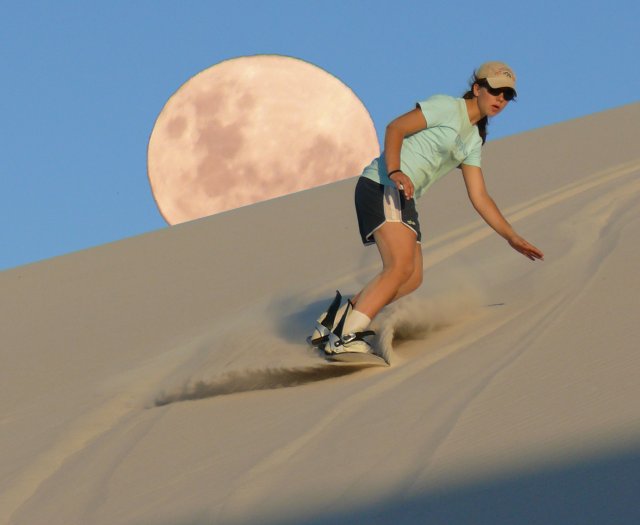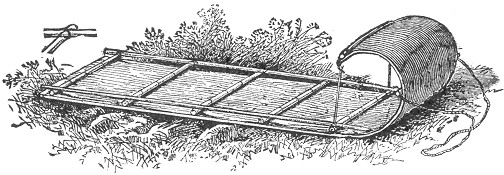|
Sledding
Sledding, sledging or sleighing is a winter sport typically carried out in a prone or seated position on a vehicle generically known as a sled (North American), a sledge (British), or a sleigh. It is the basis of three Olympic sports: luge, Skeleton (sport), skeleton and bobsledding. When practised on sand, it is known as a form of sandboarding. In Russia sledges are used for maritime activities including fishing and commuting from island to island on ice. History The practical use of sleds is ancient and widespread. They were never developed in areas with inconsistent winter snow cover, as vehicles to transport materials and/or people failed, far more people walked than used wheeled vehicles in icy and snowy conditions. Early designs included hand-pulled sizes as well as larger dog, horse, or ox drawn versions. Early examples of sleds and sledges were found in the Oseberg ship, Oseberg Viking ship excavation. The Toboggan sled is also a traditional form of transport used by ... [...More Info...] [...Related Items...] OR: [Wikipedia] [Google] [Baidu] |
Skeleton (sport)
Skeleton is a winter sliding sport in which a person rides a small sled, known as a skeleton bobsled (or bobsleigh), down a frozen track while lying face down and head-first. The sport and the sled may have been named from the bony appearance of the sled. Unlike other sliding sports of bobsleigh and luge, the race always involves single riders. Like bobsleigh, but unlike luge, the race begins with a running start from the opening gate at the top of the course. The skeleton sled is thinner and heavier than the luge sled, and skeleton gives the rider more precise control of the sled. Skeleton is the slowest of the three sliding sports, as skeleton's face-down, head-first riding position is less aerodynamic than luge's face-up, feet-first ride. Previously, skeleton appeared in the Olympic program in St. Moritz, Switzerland, in 1928 and again in 1948. It was added permanently to the Olympic program for the 2002 Winter Olympics, at which stage a women's race was added. Du ... [...More Info...] [...Related Items...] OR: [Wikipedia] [Google] [Baidu] |
Extreme Sledding
Extreme sledding is a sport where riders do not simply sled down a hill, but use the sleds and their bodies to carry out various tricks, using apparatus such as ramps, rails, ledges, and some that are performed simply riding down the hill. The types of tricks that are carried out borrow certain characteristics from snowboarding, skateboarding, aggressive in-lining, BMXing, and motocross Motocross is a form of off-road motorcycle racing held on enclosed off-road circuits. The sport evolved from motorcycle trials competitions held in the United Kingdom. History Motocross first evolved in Britain from motorcycle trials competi .... Extreme Sledding can use many different types of equipment, with the most common being "knee-sleds" which are sleds where you ride on your knees, (sometimes strapped on). Tricks References External links Mad River Rocket videos of Extreme SleddingABC News, How Sledding Became an Extreme Sport {{Extreme sports Sledding ... [...More Info...] [...Related Items...] OR: [Wikipedia] [Google] [Baidu] |
Flexible Flyer
Flexible Flyer is a toy and recreational equipment brand, best known for the sled of the same name, a steerable wooden sled with steel runners. Operation Flexible Flyers are flexible both in design and usage. Riders may sit upright on the sled or lie on their stomachs, allowing the possibility to descend a snowy slope feet-first or head-first. To steer the sled, riders may either push on the wooden cross piece with their hands or feet, or pull on the rope attached to the wooden cross-piece. Shifting the cross-piece one way or the other causes the flexible rails to bend, turning the sled. History Samuel Leeds Allen patented the Flexible Flyer in 1889 in Cinnaminson, New Jersey using local children and adults to test prototypes. Allen's company flourished by selling these speedy and yet controllable sleds at a time when others were still producing toboggans and "gooseneck" sleds. Allen began producing sleds in his farm equipment factory to keep his workers busy even ... [...More Info...] [...Related Items...] OR: [Wikipedia] [Google] [Baidu] |
Sandboarding
Sandboarding is a boardsport and extreme sport similar to snowboarding that involves riding down a sand dune while standing on a board, with both feet strapped in. Sand sledding can also be practised sitting down or lying on the belly or the back. It typically involves a sand sled, although it is also somewhat possible to use snow sleds or snowboards. The invention of modern sandboarding is largely attributed to Lon Beale, aka 'Doctor Dune', who began sandboarding in 1972 in California's Mojave Desert. Sandboarding has adherents throughout the world, but is most prevalent in desert areas or coastal areas with beach dunes. It is less popular than snowboarding, partly because it is very difficult to build a mechanised ski lift on a sand dune, meaning participants must climb or ride a dune buggy or all-terrain vehicle back to the top of the dune. On the other hand, dunes are normally available year-round as opposed to ski resorts, which are seasonal. Equipment The sandboard base ... [...More Info...] [...Related Items...] OR: [Wikipedia] [Google] [Baidu] |
Toboggan
A toboggan is a simple sled used in snowy winter recreation. It is also a traditional form of cargo transport used by the Innu, Cree and Ojibwe of North America, sometimes part of a dog train. It is used on snow to carry one or more people (often children) down a hill or other slope for recreation, or as a rescue sled. Designs vary from simple, traditional models to modern engineered composites. A toboggan differs from most sleds or sleighs in that it has no runners or skis (or only low ones) on the underside. The bottom of a toboggan rides directly on the snow. Some parks include designated toboggan hills where ordinary sleds are not allowed and which may include toboggan runs similar to bobsleigh courses. Toboggans can vary depending on the climate and geographical region. Such examples are Tangalooma (Australia) where toboggans are made from Masonite boards and used for travelling down steep sand dunes at speeds up to . Etymology The term toboggan likely comes from an ... [...More Info...] [...Related Items...] OR: [Wikipedia] [Google] [Baidu] |
Bobsled
Bobsleigh or bobsled is a winter sport in which teams of 2 to 4 athletes make timed speed runs down narrow, twisting, banked, iced tracks in a gravity-powered sleigh. International bobsleigh competitions are governed by the International Bobsleigh and Skeleton Federation (formerly the FIBT). The first bobsleds were built in the late 19th century in St. Moritz, Switzerland, by wealthy tourists from Victorian Britain who were staying at the Palace Hotel owned by Caspar Badrutt. The early sleds were adapted from boys' delivery sleds and toboggans. These eventually evolved into bobsleighs, luges and skeletons. Initially the tourists would race their hand-built contraptions down the narrow streets of St. Moritz; however, as collisions increased, growing opposition from St. Moritz residents led to bobsledding being eventually banned from public highways. In the winter of 1884, Badrutt had a purpose-built run constructed near the hamlet of Cresta. The Cresta Run remains the o ... [...More Info...] [...Related Items...] OR: [Wikipedia] [Google] [Baidu] |
Samuel Leeds Allen
Samuel Leeds Allen (May 5, 1841 – March 28, 1918) was the founder of S.L. Allen & Company in Philadelphia. He was the inventor of, and his company manufactured, both the Flexible Flyer sled and Planet Jr farm and garden equipment. For over one hundred years these products were the best selling and most famous market gardening tools and American sleds. During his lifetime and for the first half of the 20th century S.L. Allen was far more renowned for his company's seed drills and cultivating equipment than the sleds. Biography Allen was born on May 5, 1841, in Philadelphia to Quaker parents: John Casdorp Allen, a prominent druggist, and Rebecca Smith Leeds, his wife. In 1861, Allen moved to ''Ivystone'', his father's farm near the community of Westfield in Cinnaminson Township, New Jersey. On November 22, 1866, Samuel Leeds Allen and Sarah Hooton Roberts, the daughter of Elisha Roberts and Elizabeth West Hooton, were married in the Friends Meeting House, Moorestown, New Jersey ... [...More Info...] [...Related Items...] OR: [Wikipedia] [Google] [Baidu] |
Luge
A luge () is a small one- or two-person sled on which one sleds Supine position, supine (face-up) and feet-first. A luger begins seated, propelling themselves initially from handles on either side of the start ramp, then steers by using the Calf (leg), calf muscles to flex the sled's runners or by exerting opposite shoulder pressure to the pod. Racing sleds weigh for singles and for doubles. Luge is also the name of an Olympic sport that employs that sled and technique. It is not to be confused with Skeleton (sport), skeleton bob, which is also a single person tray-like sled in the Bobsleigh family, and the name of the sport that uses that sled, but which is designed for a running start, steering by shoulders and feet, and to be laid on face down and head first. While skeleton and bobsleigh are part of one international federation and sport, luge is organised separately by the International Luge Federation (FIL). Lugers can reach speeds of over 140 km/h (87 mph), ... [...More Info...] [...Related Items...] OR: [Wikipedia] [Google] [Baidu] |
Sled
A sled, skid, sledge, or sleigh is a land vehicle that slides across a surface, usually of ice or snow. It is built with either a smooth underside or a separate body supported by two or more smooth, relatively narrow, longitudinal runners similar in principle to skis. This reduces the amount of friction, which helps to carry heavy loads. Some designs are used to transport passengers or cargo across relatively level ground. Others are designed to go downhill for recreation, particularly by children, or competition (compare cross-country skiing with its downhill cousin). Shades of meaning differentiating the three terms often reflect regional variations depending on historical uses and prevailing climate. In British English, ''sledge'' is the general term, and more common than ''sled''. '' Toboggan'' is sometimes used synonymously with ''sledge'' but more often to refer to a particular type of sledge without runners. ''Sleigh'' refers to a moderate to large-sized, usuall ... [...More Info...] [...Related Items...] OR: [Wikipedia] [Google] [Baidu] |
Luge
A luge () is a small one- or two-person sled on which one sleds Supine position, supine (face-up) and feet-first. A luger begins seated, propelling themselves initially from handles on either side of the start ramp, then steers by using the Calf (leg), calf muscles to flex the sled's runners or by exerting opposite shoulder pressure to the pod. Racing sleds weigh for singles and for doubles. Luge is also the name of an Olympic sport that employs that sled and technique. It is not to be confused with Skeleton (sport), skeleton bob, which is also a single person tray-like sled in the Bobsleigh family, and the name of the sport that uses that sled, but which is designed for a running start, steering by shoulders and feet, and to be laid on face down and head first. While skeleton and bobsleigh are part of one international federation and sport, luge is organised separately by the International Luge Federation (FIL). Lugers can reach speeds of over 140 km/h (87 mph), ... [...More Info...] [...Related Items...] OR: [Wikipedia] [Google] [Baidu] |







